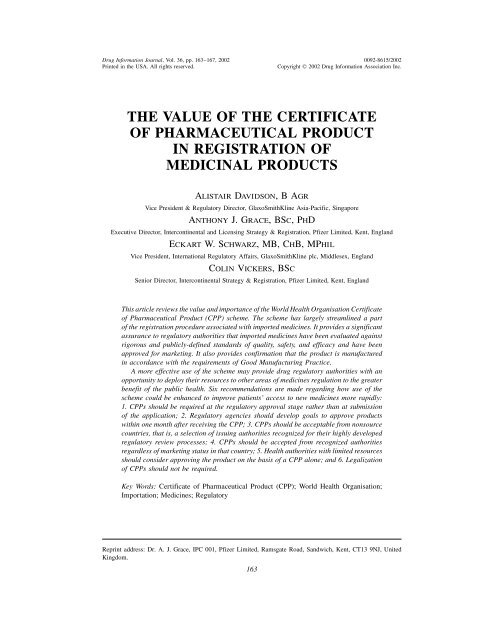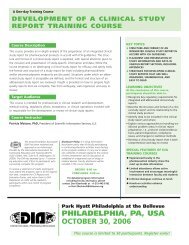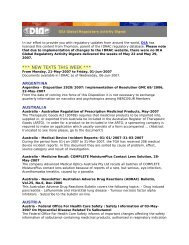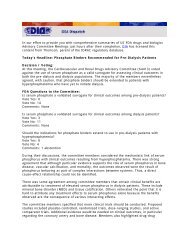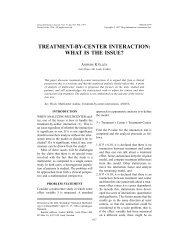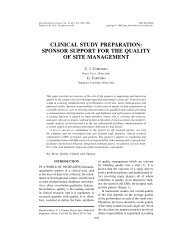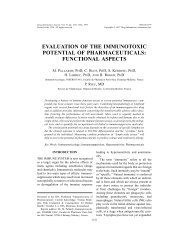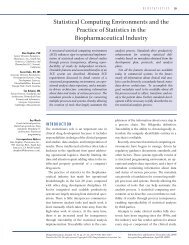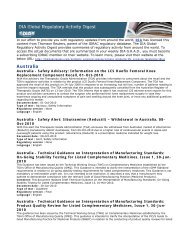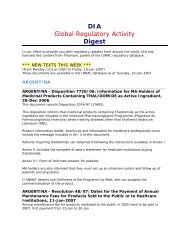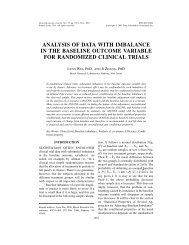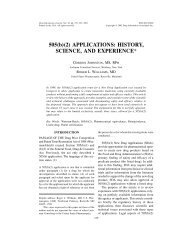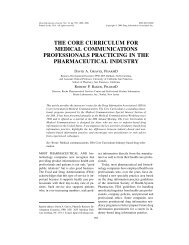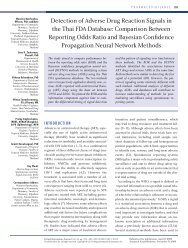the value of the certificate of pharmaceutical product in registration ...
the value of the certificate of pharmaceutical product in registration ...
the value of the certificate of pharmaceutical product in registration ...
You also want an ePaper? Increase the reach of your titles
YUMPU automatically turns print PDFs into web optimized ePapers that Google loves.
Drug Information Journal, Vol. 36, pp. 163–167, 2002 0092-8615/2002<br />
Pr<strong>in</strong>ted <strong>in</strong> <strong>the</strong> USA. All rights reserved. Copyright © 2002 Drug Information Association Inc.<br />
THE VALUE OF THE CERTIFICATE<br />
OF PHARMACEUTICAL PRODUCT<br />
IN REGISTRATION OF<br />
MEDICINAL PRODUCTS<br />
ALISTAIR DAVIDSON, BAGR<br />
Vice President & Regulatory Director, GlaxoSmithKl<strong>in</strong>e Asia-Pacific, S<strong>in</strong>gapore<br />
ANTHONY J. GRACE, BSC, PHD<br />
Executive Director, Intercont<strong>in</strong>ental and Licens<strong>in</strong>g Strategy & Registration, Pfizer Limited, Kent, England<br />
ECKART W. SCHWARZ, MB,CHB, MPHIL<br />
Vice President, International Regulatory Affairs, GlaxoSmithKl<strong>in</strong>e plc, Middlesex, England<br />
COLIN VICKERS, BSC<br />
Senior Director, Intercont<strong>in</strong>ental Strategy & Registration, Pfizer Limited, Kent, England<br />
This article reviews <strong>the</strong> <strong>value</strong> and importance <strong>of</strong> <strong>the</strong> World Health Organisation Certificate<br />
<strong>of</strong> Pharmaceutical Product (CPP) scheme. The scheme has largely streaml<strong>in</strong>ed a part<br />
<strong>of</strong> <strong>the</strong> <strong>registration</strong> procedure associated with imported medic<strong>in</strong>es. It provides a significant<br />
assurance to regulatory authorities that imported medic<strong>in</strong>es have been evaluated aga<strong>in</strong>st<br />
rigorous and publicly-def<strong>in</strong>ed standards <strong>of</strong> quality, safety, and efficacy and have been<br />
approved for market<strong>in</strong>g. It also provides confirmation that <strong>the</strong> <strong>product</strong> is manufactured<br />
<strong>in</strong> accordance with <strong>the</strong> requirements <strong>of</strong> Good Manufactur<strong>in</strong>g Practice.<br />
A more effective use <strong>of</strong> <strong>the</strong> scheme may provide drug regulatory authorities with an<br />
opportunity to deploy <strong>the</strong>ir resources to o<strong>the</strong>r areas <strong>of</strong> medic<strong>in</strong>es regulation to <strong>the</strong> greater<br />
benefit <strong>of</strong> <strong>the</strong> public health. Six recommendations are made regard<strong>in</strong>g how use <strong>of</strong> <strong>the</strong><br />
scheme could be enhanced to improve patients’ access to new medic<strong>in</strong>es more rapidly:<br />
1. CPPs should be required at <strong>the</strong> regulatory approval stage ra<strong>the</strong>r than at submission<br />
<strong>of</strong> <strong>the</strong> application; 2. Regulatory agencies should develop goals to approve <strong>product</strong>s<br />
with<strong>in</strong> one month after receiv<strong>in</strong>g <strong>the</strong> CPP; 3. CPPs should be acceptable from nonsource<br />
countries, that is, a selection <strong>of</strong> issu<strong>in</strong>g authorities recognized for <strong>the</strong>ir highly developed<br />
regulatory review processes; 4. CPPs should be accepted from recognized authorities<br />
regardless <strong>of</strong> market<strong>in</strong>g status <strong>in</strong> that country; 5. Health authorities with limited resources<br />
should consider approv<strong>in</strong>g <strong>the</strong> <strong>product</strong> on <strong>the</strong> basis <strong>of</strong> a CPP alone; and 6. Legalization<br />
<strong>of</strong> CPPs should not be required.<br />
Key Words: Certificate <strong>of</strong> Pharmaceutical Product (CPP); World Health Organisation;<br />
Importation; Medic<strong>in</strong>es; Regulatory<br />
Repr<strong>in</strong>t address: Dr. A. J. Grace, IPC 001, Pfizer Limited, Ramsgate Road, Sandwich, Kent, CT13 9NJ, United<br />
K<strong>in</strong>gdom.<br />
163
164 A. Davidson, A. J. Grace, E. W. Schwarz, and C. Vickers<br />
INTRODUCTION In addition to <strong>the</strong> requirement for a scien-<br />
THE WORLD HEALTH Organisation at-<br />
tempts to ensure and support <strong>the</strong> safe use <strong>of</strong><br />
effective, high-quality medic<strong>in</strong>es <strong>in</strong> countries<br />
tific dossier, many regulatory authorities have<br />
developed two regulatory strategies to deal<br />
with <strong>the</strong> approval <strong>of</strong> imported medic<strong>in</strong>es:<br />
around <strong>the</strong> world where drug regulatory systems<br />
are less well developed than, for example,<br />
<strong>in</strong> Europe and North America. It sup-<br />
ports this activity with a series <strong>of</strong> guidel<strong>in</strong>es,<br />
tra<strong>in</strong><strong>in</strong>g for members <strong>of</strong> appropriate drug regulatory<br />
authorities, and an essential drugs<br />
list, to name a few examples. From <strong>the</strong> po<strong>in</strong>t<br />
<strong>of</strong> view <strong>of</strong> <strong>the</strong> <strong>pharmaceutical</strong> <strong>in</strong>dustry, which<br />
<strong>in</strong>cludes generic drug manufacturers, over-<br />
1. They require samples so that <strong>the</strong>y can analyze<br />
each medic<strong>in</strong>e to ensure that it complies<br />
with <strong>the</strong> specification <strong>in</strong>cluded <strong>in</strong> <strong>the</strong><br />
application for approval to market, and<br />
2. They demand evidence that each medic<strong>in</strong>e<br />
has been approved and marketed <strong>in</strong> one<br />
or more countries with highly developed,<br />
well-resourced regulatory systems.<br />
<strong>the</strong>-counter consumer health care suppliers,<br />
and <strong>the</strong> research-based companies, one <strong>of</strong> <strong>the</strong><br />
major <strong>in</strong>novations by <strong>the</strong> World Health Organisation<br />
toward <strong>the</strong> end <strong>of</strong> <strong>the</strong> twentieth century<br />
was <strong>the</strong> <strong>in</strong>troduction <strong>of</strong> <strong>the</strong> CPP (1). This<br />
brief paper evaluates <strong>the</strong> <strong>value</strong> and utility <strong>of</strong><br />
<strong>the</strong> CPP <strong>in</strong> relation to both <strong>the</strong> regulatory<br />
authorities and <strong>the</strong> <strong>pharmaceutical</strong> <strong>in</strong>dustry.<br />
Such evidence <strong>of</strong> approval and market<strong>in</strong>g,<br />
which used to be called a Certificate <strong>of</strong> Free<br />
Sale, historically was highly variable <strong>in</strong> for-<br />
mat and content depend<strong>in</strong>g on <strong>the</strong> country<br />
which provided it. In many cases, it also was<br />
<strong>in</strong> a language that <strong>the</strong> regulatory authorities<br />
<strong>in</strong> import<strong>in</strong>g countries did not necessarily<br />
understand. In consequence, <strong>the</strong> regulatory<br />
HISTORICAL PERSPECTIVE<br />
authorities generally required that each Certificate<br />
<strong>of</strong> Free Sale be legalized by <strong>the</strong>ir em-<br />
Governments have a duty to <strong>the</strong>ir citizens to bassy or consulate <strong>in</strong> <strong>the</strong> issu<strong>in</strong>g country <strong>in</strong><br />
protect and promote public health. One aspect order to provide <strong>the</strong> authorities with an assur-<br />
<strong>of</strong> that duty is to ensure, as far as possible, ance that it was a valid document. The World<br />
that commercially available medic<strong>in</strong>es are Health Organisation developed <strong>the</strong> CPP <strong>in</strong> or-<br />
effective and <strong>of</strong> acceptable safety and quality. der to simplify and improve this process.<br />
Most countries thus have regulatory authori- CPPs are <strong>in</strong>tended to be issued <strong>in</strong> a stanties<br />
to regulate market entry <strong>of</strong> new <strong>product</strong>s. dard format such that <strong>the</strong>y are more user-<br />
Often <strong>the</strong>y also control advertis<strong>in</strong>g, <strong>in</strong>spect friendly for recipient regulatory authorities.<br />
pharmacies, ensure that local <strong>pharmaceutical</strong><br />
manufacturers use Good Manufactur<strong>in</strong>g Prac-<br />
They provide <strong>the</strong> follow<strong>in</strong>g <strong>in</strong>formation:<br />
tice (GMP), and so on. Many countries have • Confirmation that <strong>the</strong> regulatory authority<br />
limited resources to support <strong>the</strong> approval pro- has reviewed <strong>the</strong> application and deemed<br />
cess for new, research-based medic<strong>in</strong>es, l<strong>in</strong>e it satisfactory, on <strong>the</strong> basis <strong>of</strong> quality,<br />
extensions (additional formulations or cl<strong>in</strong>i- safety, and efficacy to be placed on <strong>the</strong><br />
cal <strong>in</strong>dications), or manufactur<strong>in</strong>g changes. market,<br />
The same applies to consumer health medi- • Details <strong>of</strong> <strong>the</strong> date <strong>of</strong> approval and <strong>the</strong> regc<strong>in</strong>es,<br />
generic medic<strong>in</strong>es and, <strong>in</strong>deed, to tra- istration number,<br />
ditional or herbal medic<strong>in</strong>es.<br />
• Confirmation that <strong>the</strong> medic<strong>in</strong>e is manufac-<br />
The issue is particularly acute, however, tured <strong>in</strong> accordance with <strong>the</strong> requirements<br />
<strong>in</strong> relation to imported medic<strong>in</strong>es. The regu- <strong>of</strong> GMP,<br />
latory authorities concerned have few or no • The formulation <strong>of</strong> <strong>the</strong> medic<strong>in</strong>e,<br />
resources to <strong>in</strong>spect foreign manufacturers • Information on whe<strong>the</strong>r <strong>the</strong> <strong>product</strong> is mar-<br />
and thus <strong>the</strong>re is <strong>the</strong> potential risk that im- keted. A CPP may be issued <strong>in</strong> those cases<br />
ported medic<strong>in</strong>es may not have been manu- where a medic<strong>in</strong>e is not marketed <strong>in</strong> <strong>the</strong><br />
factured to a high quality <strong>in</strong> accordance with country provid<strong>in</strong>g <strong>the</strong> CPP. This may occur,<br />
GMP.<br />
for example, when <strong>the</strong> medic<strong>in</strong>e is for a
The Value <strong>of</strong> <strong>the</strong> Certificate <strong>of</strong> Pharmaceutical Product 165<br />
tropical disease although <strong>the</strong> manufacturer at any time after <strong>the</strong> supply <strong>of</strong> a CPP, or if<br />
is <strong>in</strong> a temperate country, and<br />
an issue <strong>of</strong> safety arose. The availability <strong>of</strong><br />
• In many cases, <strong>the</strong> issu<strong>in</strong>g country will also a CPP, however, provides an element <strong>of</strong><br />
attach a copy <strong>of</strong> <strong>the</strong> authorized <strong>product</strong> <strong>in</strong>- choice for regulatory authorities that preformation.<br />
viously was not present. That choice is how<br />
best to deploy <strong>the</strong>ir resources <strong>in</strong> order to pro-<br />
THE VALUE OF CPPS<br />
tect and promote <strong>the</strong> public health.<br />
Is it necessary, <strong>the</strong>refore, for regulatory<br />
A CPP provides def<strong>in</strong>itive evidence, <strong>in</strong> a rela- authorities <strong>in</strong> import<strong>in</strong>g countries to undertively<br />
standard format, that a particular medi- take an <strong>in</strong>dependent scientific and medical<br />
c<strong>in</strong>e has been evaluated and approved for mar- evaluation <strong>of</strong> a dossier <strong>of</strong> data on a medic<strong>in</strong>e?<br />
ket<strong>in</strong>g <strong>in</strong> <strong>the</strong> country that issued <strong>the</strong> CPP. In <strong>the</strong> This question does not suggest that regula-<br />
case <strong>of</strong> a CPP from <strong>the</strong> European Medic<strong>in</strong>es tory authorities should not fulfill <strong>the</strong>ir duty<br />
Evaluation Agency, which is a transnational <strong>of</strong> care <strong>in</strong> relation to public health and medi-<br />
authority, <strong>the</strong> document <strong>in</strong>dicates that <strong>the</strong> medic<strong>in</strong>es, as mentioned earlier.<br />
c<strong>in</strong>e concerned is approved for market<strong>in</strong>g <strong>in</strong> all Also, is a full scientific and medical eval-<br />
<strong>of</strong> <strong>the</strong> Member States <strong>of</strong> <strong>the</strong> European Union uation <strong>of</strong> a <strong>registration</strong> dossier go<strong>in</strong>g to add<br />
(currently Austria, Belgium, Denmark, F<strong>in</strong>- <strong>value</strong> relative to <strong>the</strong> assurances <strong>of</strong> quality,<br />
land, France, Germany, Greece, Ireland, Italy, safety, and efficacy provided by a CPP? It is<br />
Luxembourg, Ne<strong>the</strong>rlands, Portugal, Spa<strong>in</strong>, unlikely, unless <strong>the</strong>re are clear reasons why<br />
Sweden, and <strong>the</strong> United K<strong>in</strong>gdom).<br />
a medic<strong>in</strong>e should affect a particular commu-<br />
The majority <strong>of</strong> CPPs are issued by terri- nity <strong>of</strong> patients <strong>in</strong> a manner different than<br />
tories <strong>in</strong>volved <strong>in</strong> <strong>the</strong> International Confer- those <strong>in</strong> <strong>the</strong> territory provid<strong>in</strong>g <strong>the</strong> CPP, for<br />
ence on Harmonization (ICH) process (Ja- example, due to significant differences <strong>in</strong> diet<br />
pan, <strong>the</strong> European Union, and <strong>the</strong> United or <strong>the</strong> local practice <strong>of</strong> medic<strong>in</strong>e.<br />
States) or by countries such as Canada and Similarly <strong>in</strong> terms <strong>of</strong> regulatory samples,<br />
Australia that rapidly adopt f<strong>in</strong>al ICH guide- is it a valuable use <strong>of</strong> regulatory authorities’<br />
l<strong>in</strong>es. As such, <strong>the</strong> standards for development resources to analyze <strong>the</strong>m dur<strong>in</strong>g <strong>the</strong> approval<br />
and approval <strong>of</strong> medic<strong>in</strong>es <strong>in</strong> <strong>the</strong>se territories process? A more valuable utilization <strong>of</strong> regu-<br />
are well established and publicly available. latory agency resources would be to monitor<br />
Regulatory authorities <strong>in</strong> import<strong>in</strong>g countries <strong>the</strong> quality <strong>of</strong> <strong>product</strong>s placed on <strong>the</strong> market<br />
thus can have an extremely clear vision <strong>of</strong> after approval, to ensure that <strong>the</strong> quality is<br />
<strong>the</strong> standards <strong>of</strong> Good Laboratory Practice, ma<strong>in</strong>ta<strong>in</strong>ed over time and that counterfeit<br />
Good Cl<strong>in</strong>ical Practice, and GMP to which medic<strong>in</strong>es are not be<strong>in</strong>g sold. The choice faca<br />
CPP relates for a particular medic<strong>in</strong>e. In <strong>in</strong>g regulatory agencies <strong>in</strong> import<strong>in</strong>g coun-<br />
essence, such a CPP <strong>in</strong>dicates that <strong>the</strong> medi- tries thus is whe<strong>the</strong>r to cont<strong>in</strong>ue to provide<br />
c<strong>in</strong>e concerned is effective, <strong>of</strong> satisfactory resources, effectively duplicat<strong>in</strong>g a regula-<br />
safety and quality, and that it was developed tory evaluation that has taken place else-<br />
<strong>in</strong> accordance with <strong>the</strong> current requirements where, or to rely on <strong>the</strong> assurances provided<br />
<strong>of</strong> medical science. by CPPs and redeploy those resources to<br />
A regulatory authority or agency which o<strong>the</strong>r areas <strong>of</strong> medic<strong>in</strong>es regulation. Such<br />
issues CPPs is obliged by <strong>the</strong> World Health o<strong>the</strong>r areas <strong>of</strong> importance for public health<br />
Organisation guidel<strong>in</strong>e to notify all <strong>of</strong> <strong>the</strong> purposes may <strong>in</strong>clude regulation and <strong>in</strong>specrecipient<br />
countries <strong>of</strong> a CPP for a particular tion <strong>of</strong> local manufacturers, regulation and<br />
medic<strong>in</strong>e should it subsequently be consid- <strong>in</strong>spection <strong>of</strong> storage and distribution <strong>of</strong> medered<br />
that that medic<strong>in</strong>e may no longer be ic<strong>in</strong>es, ongo<strong>in</strong>g evaluation <strong>of</strong> <strong>in</strong>formation<br />
acceptable for market<strong>in</strong>g. Thus, regulatory provided with medic<strong>in</strong>es by manufacturers,<br />
authorities <strong>in</strong> import<strong>in</strong>g countries would be control <strong>of</strong> advertis<strong>in</strong>g to ensure that it is <strong>in</strong><br />
<strong>in</strong>formed, for example, should a manufac- compliance with <strong>the</strong> market<strong>in</strong>g authorizaturer<br />
fail to comply with GMP requirements tion, regulation and <strong>in</strong>spection <strong>of</strong> pharma-
166 A. Davidson, A. J. Grace, E. W. Schwarz, and C. Vickers<br />
cies, planned surveillance and sampl<strong>in</strong>g <strong>of</strong> thorities that do not need a CPP for submis-<br />
<strong>the</strong> quality <strong>of</strong> marketed <strong>product</strong>s, and pharsion or approval.<br />
macovigilance. This list is not <strong>in</strong>tended to be The impact <strong>of</strong> this is to delay <strong>the</strong> availabildef<strong>in</strong>itive,<br />
it is simply an example <strong>of</strong> o<strong>the</strong>r ity <strong>of</strong> new medic<strong>in</strong>es to patients. As <strong>the</strong> regu-<br />
activities that help ensure and protect public latory evaluation process <strong>in</strong> <strong>the</strong> ICH-associ-<br />
health and which must be managed by <strong>the</strong> ated territories, for example, can take more<br />
appropriate government authorities. than a year, this time period must be added on<br />
In <strong>the</strong> <strong>pharmaceutical</strong> <strong>in</strong>dustry <strong>the</strong>re is a to <strong>the</strong> time taken for approval <strong>of</strong> medic<strong>in</strong>es <strong>in</strong><br />
clear understand<strong>in</strong>g that any regulatory agency import<strong>in</strong>g countries where a CPP must be<br />
<strong>in</strong> any country has <strong>the</strong> right to request sam- supplied with <strong>the</strong> application for market<strong>in</strong>g<br />
ples <strong>of</strong> a medic<strong>in</strong>e as part <strong>of</strong> an application to authorization. This appears to be an unneces-<br />
market, and also to raise scientific and medical sary impediment to market<strong>in</strong>g approval and<br />
queries when <strong>the</strong>re are concerns regard<strong>in</strong>g adds noth<strong>in</strong>g to <strong>the</strong> protection and promotion<br />
<strong>the</strong> impact <strong>of</strong> that medic<strong>in</strong>e on <strong>the</strong> public <strong>of</strong> public health. Fur<strong>the</strong>rmore, as <strong>the</strong> success<br />
health. The advent <strong>of</strong> <strong>the</strong> CPP and its wide- rate <strong>of</strong> all applications <strong>in</strong> ICH regions is im-<br />
spread usage dur<strong>in</strong>g recent years, however, prov<strong>in</strong>g—over 95% <strong>of</strong> all applications are<br />
suggest that its major <strong>value</strong> to regulatory agen- approved (3), regulatory authorities should<br />
cies <strong>in</strong> import<strong>in</strong>g countries may be to allow have confidence <strong>in</strong> commenc<strong>in</strong>g review prior<br />
<strong>the</strong>m to focus scarce resources more effec- to CPP availability.<br />
tively to <strong>the</strong> benefit <strong>of</strong> public health.<br />
Ano<strong>the</strong>r issue fac<strong>in</strong>g those wish<strong>in</strong>g to ga<strong>in</strong><br />
The World Health Organisation recom- market<strong>in</strong>g authorizations is that some regula-<br />
mends a standard format for <strong>the</strong> CPP. Unfortory agencies <strong>in</strong>sist that a CPP for a medic<strong>in</strong>e<br />
tunately, however, <strong>the</strong>re are some regulatory should be provided from <strong>the</strong> country where<br />
agencies <strong>in</strong> import<strong>in</strong>g countries that still <strong>in</strong>- it is manufactured. In fact, <strong>the</strong> requirement<br />
sist on legalization, even though <strong>the</strong> World is now irrelevant and should be discont<strong>in</strong>ued.<br />
Health Organisation guidel<strong>in</strong>e does not men- A country that does issue a CPP will have<br />
tion that this is necessary. This situation leads assured itself <strong>of</strong> <strong>the</strong> medic<strong>in</strong>e’s quality, safety,<br />
to confusion and thus, more significantly, has and efficacy and that it is manufactured <strong>in</strong><br />
<strong>the</strong> potential to delay access to new medi- accordance with GMP. This will be ei<strong>the</strong>r by<br />
c<strong>in</strong>es. For example, a recent survey <strong>of</strong> a num- direct <strong>in</strong>spection <strong>of</strong> <strong>the</strong> manufactur<strong>in</strong>g site(s)<br />
ber <strong>of</strong> companies <strong>in</strong> Europe <strong>in</strong>dicated signifi- or by mutual recognition <strong>of</strong> a satisfactory<br />
cant variation <strong>in</strong> <strong>the</strong>ir understand<strong>in</strong>g <strong>of</strong> CPP <strong>in</strong>spection carried out and reported by an-<br />
legalization requirements across a range <strong>of</strong> o<strong>the</strong>r competent regulatory authority.<br />
80 countries (2).<br />
As such, <strong>the</strong>refore, a requirement for a<br />
The utility <strong>of</strong> CPPs <strong>in</strong> support <strong>of</strong> applica- CPP from <strong>the</strong> manufactur<strong>in</strong>g source country<br />
tions to market medic<strong>in</strong>es is variable depend- adds no <strong>value</strong> or additional assurances as to<br />
<strong>in</strong>g on <strong>the</strong> import<strong>in</strong>g country concerned. In <strong>the</strong> medic<strong>in</strong>e’s quality, safety, and efficacy.<br />
some countries, <strong>the</strong> regulatory agency will In addition <strong>the</strong>re is no consistent def<strong>in</strong>ition<br />
accept an application for market<strong>in</strong>g authori- <strong>of</strong> site <strong>of</strong> manufacture and, as manufactur<strong>in</strong>g<br />
zation <strong>in</strong> <strong>the</strong> absence <strong>of</strong> a CPP, on <strong>the</strong> basis strategies develop and manufactur<strong>in</strong>g sites<br />
that one must be provided before <strong>the</strong> applica- become more specialized, it becomes even<br />
tion is f<strong>in</strong>ally approved. O<strong>the</strong>r regulatory au- more important to rely on global GMP stanthorities,<br />
however, will not accept a dossier dards. An example would be <strong>the</strong> secondary<br />
unless it is accompanied by a CPP at <strong>the</strong> packag<strong>in</strong>g <strong>of</strong> a variety <strong>of</strong> <strong>product</strong>s not neces-<br />
time <strong>of</strong> submission. Even <strong>the</strong>n, <strong>the</strong> time to sarily manufactured at a particular site but<br />
complete evaluation (<strong>of</strong>ten <strong>the</strong>re are long packaged and quality released at <strong>the</strong> site. Fi-<br />
queues for <strong>the</strong> assessment <strong>in</strong> regulatory agen- nally, certification confirms that <strong>the</strong> regula-<br />
cies) is a lot longer and much less predictable tory authority has evaluated <strong>the</strong> application<br />
than those established by <strong>the</strong> regulatory au- and approved it on <strong>the</strong> basis <strong>of</strong> quality, safety,
The Value <strong>of</strong> <strong>the</strong> Certificate <strong>of</strong> Pharmaceutical Product 167<br />
and efficacy. Issu<strong>in</strong>g a CPP confirms quality, such as one month, after receiv<strong>in</strong>g a CPP.<br />
safety, and efficacy and is not l<strong>in</strong>ked to mar- This would be <strong>of</strong> <strong>value</strong> from a public health<br />
ket<strong>in</strong>g status (ie, whe<strong>the</strong>r a <strong>product</strong> is sold po<strong>in</strong>t <strong>of</strong> view,<br />
<strong>in</strong> a given market.)<br />
• CPPs from recognized health authorities<br />
(eg, European Union and Member States,<br />
CONCLUSIONS<br />
The World Health Organisation’s CPP scheme<br />
has largely harmonized a part <strong>of</strong> <strong>the</strong> <strong>registration</strong><br />
process for medic<strong>in</strong>es that are be<strong>in</strong>g imported<br />
from ano<strong>the</strong>r country. The major <strong>value</strong><br />
<strong>of</strong> a CPP to an import<strong>in</strong>g country is that it<br />
provides significant assurance that <strong>the</strong> medic<strong>in</strong>e<br />
to which it relates has been rigorously<br />
evaluated to def<strong>in</strong>ed, published standards,<br />
and that it has been approved for plac<strong>in</strong>g it<br />
on <strong>the</strong> market. By rely<strong>in</strong>g more heavily on<br />
this assurance, ra<strong>the</strong>r than repeat<strong>in</strong>g a scientific<br />
and medical assessment <strong>of</strong> data, regulatory<br />
agencies <strong>in</strong> <strong>the</strong> import<strong>in</strong>g countries have<br />
an opportunity to refocus scarce and valuable<br />
resources onto o<strong>the</strong>r aspects <strong>of</strong> medic<strong>in</strong>es regulation<br />
to <strong>the</strong> greater benefit <strong>of</strong> <strong>the</strong> public health<br />
United States, Japan, Canada, Australia)<br />
and not only <strong>the</strong> source country should be<br />
acceptable,<br />
• CPPs should be accepted from recognized<br />
authorities regardless <strong>of</strong> market<strong>in</strong>g status<br />
<strong>in</strong> that country,<br />
• Regulatory agencies with limited resources<br />
for review<strong>in</strong>g <strong>the</strong> application should con-<br />
sider approv<strong>in</strong>g <strong>the</strong> <strong>product</strong> on <strong>the</strong> basis <strong>of</strong><br />
a CPP alone, keep<strong>in</strong>g technical data pro-<br />
vided for future reference, and<br />
• As recommended by <strong>the</strong> World Health Or-<br />
ganisation, legalization <strong>of</strong> CPPs should not<br />
be required. Legalization adds no <strong>value</strong> and<br />
<strong>in</strong>creases <strong>the</strong> duration <strong>of</strong> <strong>the</strong> <strong>registration</strong><br />
process.<br />
and safety.<br />
REFERENCES<br />
Fur<strong>the</strong>rmore, <strong>the</strong> use <strong>of</strong> CPPs could significantly<br />
benefit both regulatory agencies<br />
and patients based on <strong>the</strong> follow<strong>in</strong>g recom-<br />
1. World Health Organisation Expert Committee on<br />
Specifications for Pharmaceutical Preparations 34th<br />
Report. WHO Technical Report Series No. 863. Ge-<br />
mendations:<br />
neva, Switzerland: World Health Organisation; 1996:<br />
155–177.<br />
• CPPs should be required before approval<br />
to market is granted, not at <strong>the</strong> time <strong>of</strong><br />
application. This will reduce <strong>the</strong> time to<br />
2. Transnational Regulatory Affairs Group, Association<br />
<strong>of</strong> <strong>the</strong> British Pharmaceutical Industry. Survey <strong>of</strong><br />
member companies regard<strong>in</strong>g use <strong>of</strong> Certificates <strong>of</strong><br />
Pharmaceutical Product. London, England: Associa-<br />
market, potentially by a year or more, and tion <strong>of</strong> <strong>the</strong> British Pharmaceutical Industy; April 2000.<br />
thus, is <strong>of</strong> benefit to patients, health care 3. Walker S. Trends <strong>in</strong> Pharmaceutical Research and<br />
pr<strong>of</strong>essionals, and public health,<br />
• Regulatory agencies ideally should develop<br />
goals such that <strong>the</strong>y aim to approve each<br />
Development, DIA Regulatory Forum—Harmoni-<br />
sation <strong>of</strong> Drug Regulations <strong>in</strong> Lat<strong>in</strong> America: The<br />
Road to Quality, Safe, and Effective Medic<strong>in</strong>es, Santi-<br />
ago, Chile. Epsom, England: Center for Medic<strong>in</strong>es<br />
market<strong>in</strong>g application with<strong>in</strong> a def<strong>in</strong>ed time,<br />
Research; May 2001.


